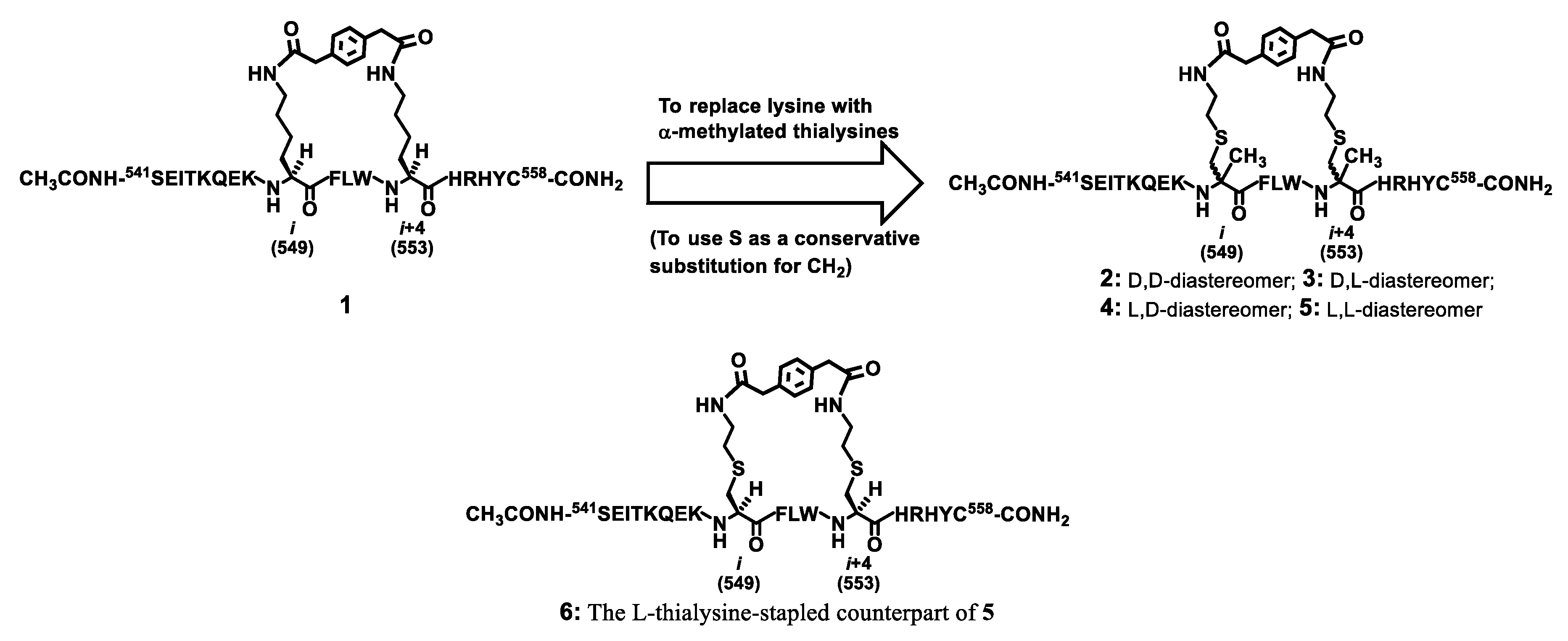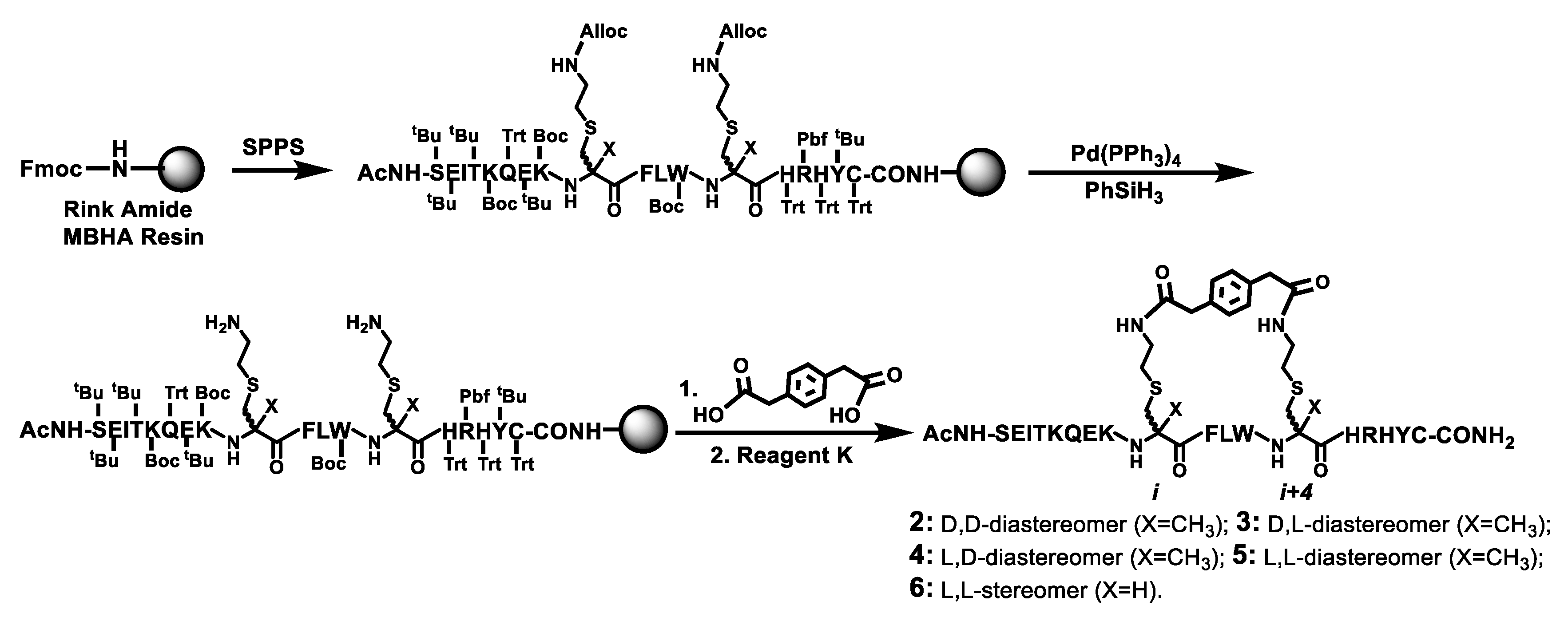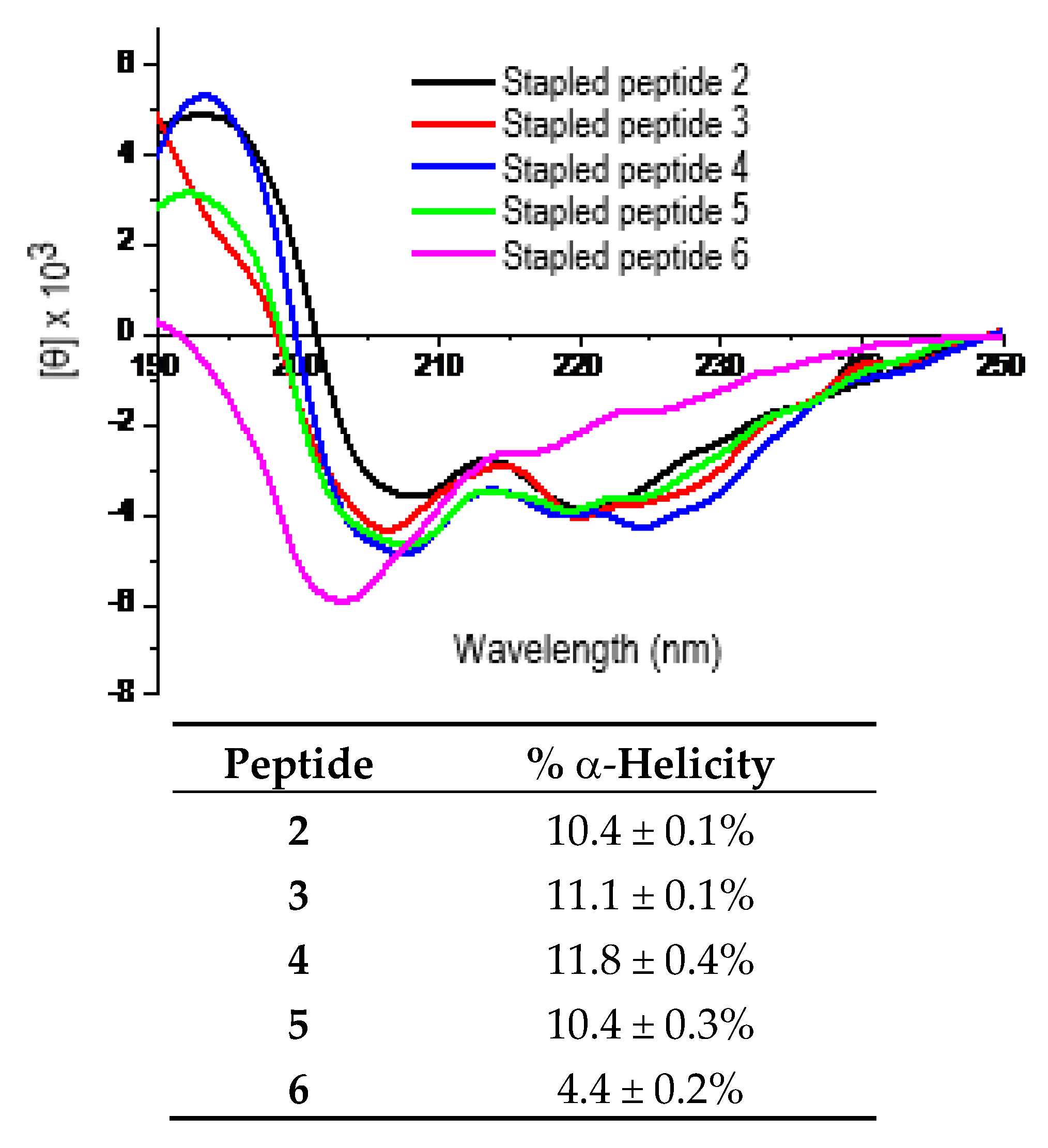Bis-Lactam Peptide [i, i+4]-Stapling with α-Methylated Thialysines
Abstract
:1. Introduction
2. Results and Discussion
2.1. Stapled Peptides 2–6: Design
2.2. Stapled Peptides 2–6: Preparation
2.3. Stapled Peptides 2–6: CD Measurement
2.4. Stapled Peptides 5 and 6: Proteolytic Stability Assessment
2.5. Stapled Peptides 7 and 8: Preparation, CD Measurement, and Proteolytic Stability Assessment
3. Experimental Section
3.1. General
3.2. Compound Preparation
3.2.1. Preparation of the Fmoc,Alloc-diprotected d-/l-α-methyl-thialysines and the Fmoc,Alloc-diprotected l-thialysine
3.2.2. Preparation of the Stapled Peptides 2–6
3.2.3. Preparation of the Stapled Peptides 7 and 8
3.3. CD Experiment
3.4. Proteolysis Experiment
4. Conclusions
Author Contributions
Funding
Acknowledgments
Conflicts of Interest
References
- Choi, J.S.; Joo, S.H. Recent trends in cyclic peptides as therapeutic agents and biochemical tools. Biomol. Ther. (Seoul) 2020, 28, 18–24. [Google Scholar] [CrossRef] [PubMed]
- Moiola, M.; Memeo, M.G.; Quadrelli, P. Stapled peptides - a useful improvement for peptide-based drugs. Molecules 2019, 24, 3654. [Google Scholar] [CrossRef] [Green Version]
- Hillman, R.A.; Nadraws, J.W.; Bertucci, M.A. The hydrocarbon staple & beyond: Recent advances towards stapled peptide therapeutics that target protein-protein interactions. Curr. Top. Med. Chem. 2018, 18, 611–624. [Google Scholar] [PubMed]
- Klein, M. Stabilized helical peptides: Overview of the technologies and its impact on drug discovery. Expert Opin. Drug Discov. 2017, 12, 1117–1125. [Google Scholar] [CrossRef] [PubMed]
- He, Y.; Chen, D.; Zheng, W. An enhanced functional interrogation/manipulation of intracellular signaling pathways with the peptide “stapling” technology. Oncogene 2015, 34, 5685–5698. [Google Scholar] [CrossRef] [PubMed]
- Lau, Y.H.; de Andrade, P.; Wu, Y.; Spring, D.R. Peptide stapling techniques based on different macrocyclisation chemistries. Chem. Soc. Rev. 2015, 44, 91–102. [Google Scholar] [CrossRef] [PubMed]
- Walensky, L.D.; Bird, G.H. Hydrocarbon-stapled peptides: Principles, practice, and progress. J. Med. Chem. 2014, 57, 6275–6288. [Google Scholar] [CrossRef] [Green Version]
- Verdine, G.L.; Hilinski, G.J. Stapled peptides for intracellular drug targets. Methods Enzymol. 2012, 503, 3–33. [Google Scholar]
- Schafmeister, C.E.; Po, J.; Verdine, G.L. An all-hydrocarbon cross-linking system for enhancing the helicity and metabolic stability of peptides. J. Am. Chem. Soc. 2000, 122, 5891–5892. [Google Scholar] [CrossRef]
- Fujimoto, K.; Kajino, M.; Inouye, M. Development of a series of cross-linking agents that effectively stabilize alpha-helical structures in various short peptides. Chem. Eur. J. 2008, 14, 857–863. [Google Scholar] [CrossRef]
- Flint, D.G.; Kumita, J.R.; Smart, O.S.; Woolley, G.A. Using an azobenzene cross-linker to either increase or decrease peptide helix content upon trans-to-cis photoisomerization. Chem. Biol. 2002, 9, 391–397. [Google Scholar] [CrossRef] [Green Version]
- Shim, S.Y.; Kim, Y.-W.; Verdine, G.L. A new i, i + 3 peptide stapling system for α-helix stabilization. Chem. Biol. Drug Des. 2013, 82, 635–642. [Google Scholar] [CrossRef] [PubMed]
- Kim, Y.-W.; Kutchukian, P.S.; Verdine, G.L. Introduction of all-hydrocarbon i,i+3 staples into alpha-helices via ring-closing olefin metathesis. Org. Lett. 2010, 12, 3046–3049. [Google Scholar] [CrossRef] [PubMed]
- Yeo, D.J.; Warriner, S.L.; Wilson, A.J. Monosubstituted alkenyl amino acids for peptide “stapling”. Chem. Commun. (Camb) 2013, 49, 9131–9133. [Google Scholar] [CrossRef] [PubMed] [Green Version]
- Hao, Y.; Wang, C.; Cao, B.; Hirsch, B.M.; Song, J.; Markowitz, S.D.; Ewing, R.M.; Sedwick, D.; Liu, L.; Zheng, W.; et al. Gain of interaction with IRS1 by p110α-helical domain mutants is crucial for their oncogenic functions. Cancer Cell 2013, 23, 583–593. [Google Scholar] [CrossRef] [Green Version]
- Hu, X.; Wu, B.; Zheng, W. Bis-lactam peptide [i, i+4]-stapling. Chin. J. Chem. 2019, 37, 244–248. [Google Scholar] [CrossRef]
- Meledin, R.; Mali, S.M.; Singh, S.K.; Brik, A. Protein ubiquitination via dehydroalanine: Development and insights into the diastereoselective 1,4-addition step. Org. Biomol. Chem. 2016, 14, 4817–4823. [Google Scholar] [CrossRef] [Green Version]
- Grieco, P.; Gitu, P.M.; Hruby, V.J. Preparation of “side-chain-to-side-chain” cyclic peptides by Allyl and Alloc strategy: Potential for library synthesis. J. Pept. Res. 2001, 57, 250–256. [Google Scholar] [CrossRef]
- Bird, G.H.; Bernal, F.; Pitter, K.; Walensky, L.D. Synthesis and biophysical characterization of stabilized alpha-helices of BCL-2 domains. Methods Enzymol. 2008, 446, 369–386. [Google Scholar]
- Roche Applied Science. Pronase: Product Description. Available online: https://www.sigmaaldrich.com/content/dam/sigma-aldrich/docs/Roche/Bulletin/1/pronrobul.pdf (accessed on 27 September 2020).
- Tickler, A.K.; Barrow, C.J.; Wade, J.D. Improved preparation of amyloid-beta peptides using DBU as Nalpha-Fmoc deprotection reagent. J. Pept. Sci. 2001, 7, 488–494. [Google Scholar] [CrossRef]
- Hu, X.; He, Y.; Wu, L.; Hao, Y.; Wang, Z.; Zheng, W. Novel all-hydrocarbon stapled p110α[E545K] peptides as blockers of the oncogenic p110α[E545K]-IRS1 interaction. Bioorg. Med. Chem. Lett. 2017, 27, 5446–5449. [Google Scholar] [CrossRef] [PubMed]
- Hirsch, B.M.; Gallo, C.A.; Du, Z.; Wang, Z.; Zheng, W. Discovery of potent, proteolytically stable, and cell permeable human sirtuin peptidomimetic inhibitors containing Nε-thioacetyl-lysine. Med. Chem. Comm. 2010, 1, 233–238. [Google Scholar] [CrossRef]
Sample Availability: Samples of the compounds are not available from the authors. |






| Peptide | Ionic Species | Calculated m/z | Observed m/z |
|---|---|---|---|
| 2 | [M + 2H]2+ [M + 3H]3+ [M + 4H]4+ | 1312.62 875.42 656.82 | 1313.63 876.89 657.98 |
| 3 | [M + 2H]2+ [M + 3H]3+ [M + 4H]4+ | 1312.62 875.42 656.82 | 1313.33 876.41 657.64 |
| 4 | [M + 2H]2+ [M + 3H]3+ [M + 4H]4+ [M + 5H]5+ | 1312.62 875.42 656.82 525.65 | 1313.72 876.81 658.02 526.70 |
| 5 | [M + 2H]2+ [M + 3H]3+ [M + 4H]4+ [M + 5H]5+ | 1312.62 875.42 656.82 525.65 | 1313.68 876.35 657.95 526.70 |
| 6 | [M + 2H]2+ [M + 3H]3+ | 1298.61 866.07 | 1299.67 867.74 |
| 7 | [M + H]+ [M + 2H]2+ | 1963.9 982.5 | 1964.7 983.1 |
| 8 | [M + H]+ [M + 2H]2+ | 1935.9 968.4 | 1936.5 969.3 |
© 2020 by the authors. Licensee MDPI, Basel, Switzerland. This article is an open access article distributed under the terms and conditions of the Creative Commons Attribution (CC BY) license (http://creativecommons.org/licenses/by/4.0/).
Share and Cite
Wu, B.; Zheng, W. Bis-Lactam Peptide [i, i+4]-Stapling with α-Methylated Thialysines. Molecules 2020, 25, 4506. https://doi.org/10.3390/molecules25194506
Wu B, Zheng W. Bis-Lactam Peptide [i, i+4]-Stapling with α-Methylated Thialysines. Molecules. 2020; 25(19):4506. https://doi.org/10.3390/molecules25194506
Chicago/Turabian StyleWu, Bo, and Weiping Zheng. 2020. "Bis-Lactam Peptide [i, i+4]-Stapling with α-Methylated Thialysines" Molecules 25, no. 19: 4506. https://doi.org/10.3390/molecules25194506





